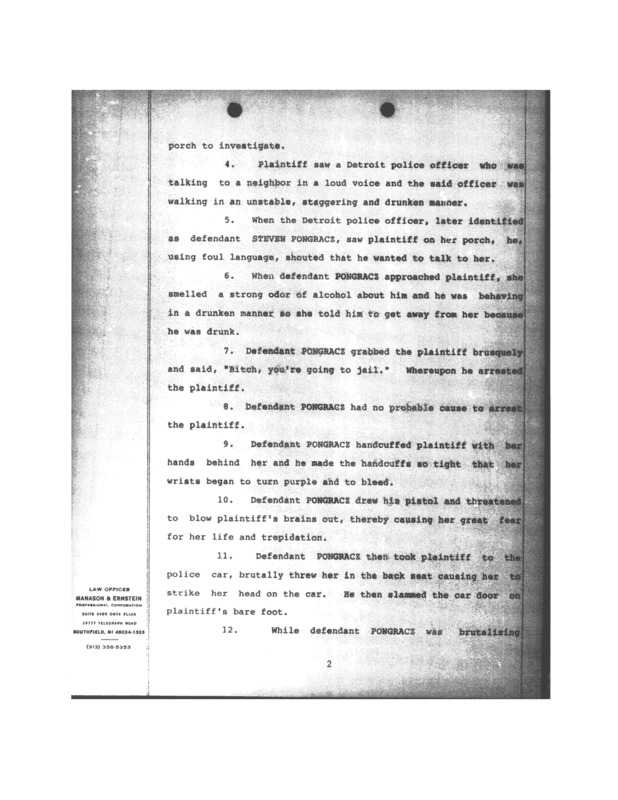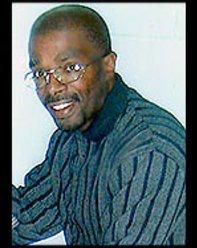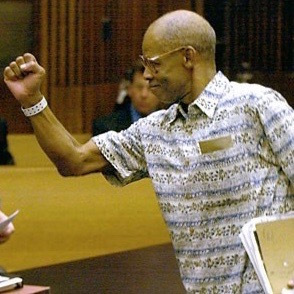Police Violence and Misconduct
These findings represent only a fraction of the evidence surrounding occurrences of police misconduct. From the Detroit Police Department’s 1982 Annual Report alone, there were 855 “formal” complaints filed against police officers. Of that 855, 311 were investigated by the Professional Standards Section, 62 by the Chief Investigator’s Office, and 482 by other departmental sections not enumerated by the department. Meanwhile, the Internal Affairs Section rejected 320 of its 424 allegations of criminal misconduct by police officers as “insufficient.” of the 104 cases taken, 56 were found to have taken part in misconduct or criminality.
The DPD Report claimed that citizen complaints declines since the 1,542 in 1978. However, the Detroit Ombudsman in 1983 reported that the year 1982 saw 1,462 complaints involving the police department, and 1,186 in 1983. 1982 showed an increase from the 1,228 in 1981, and similar numbers for the preceding 7 years.
The disparity between the DPD's report on complaints and the Ombudsman is unknown. What is clear is that there are far more citizen complaints that have not been found. Regardless, it is important to note that "formal" complaints are not a good indicator of the true amount of police violence and misconduct that occurs. Most instances of misconduct are never reported, providing silences in the archival record.
Silences in Police Violence
It is important to note the unfortunate truth that the collection of all the stories of those affected by police violence will either never surface, or had never existed in the first place. To "call the police" is not, and was not, as easy a thing to do for African-Americans and minority groups living in Detroit as it was for the white population of the suburbs that border the city limits. In the Reuther Archives, many complaints come from citizens living in suburban areas that did not necessarily have higher rates of crime than in the city. During this time, the white population grows increasingly anxious of the issues of crime and race in the City of Detroit. As the population becomes more spatially segregated, it becomes more common for white citizens to report crimes and suspicious behavior in their areas as a caricature of black crime in Detroit is broadcasting into white suburban homes.
"The Blue Code of Silence"
An obstacle for research on instances of misconduct is the endemic predisposition of police departments and individual officers to defend their own. This characteristic exists in organizations other than police departments, but is reinforced by the inherent dangers of police work. Jerome Skolnick's research article contains the findings of commission reports created by cities such as New York and Los Angeles to investigate the extent of this trend in the wake of incidents such as the 1991 police assault on Rodney King. The commissions found that an unwritten code of silence and loyalty permeates testimonies when police officers' actions are scrutinized for possible criminality. Warren Chrisopher, who headed the Los Angeles Christopher Commission after the beating of Rodney King described this code of silence,
"Perhaps the greatest single barrier to the effective investigation and adjudication of complaints is the officers’ unwritten ‘code of silence....' the code of silence influences the behavior of many officers in a variety of ways, but it consists of one simple rule: an officer does not provide adverse information against a fellow officer."
There are numerous factors that contribute to police officers' willingness to lie or omit information in defense of their colleagues: loyalty, a fear of retribution, or creating a system of "snitching and counter-snitching," on each other's immoral or illegal activities. This system is further reinforced by the culture and dangers of police work, which a contemporary Detroit Free Press reporter described as a mindset of “the ‘us versus them’, the ‘you don’t know what I put up with.’” Reportedly, a state prosecutor would joke about police officers' testimonies by exclaiming in court "Bring out the defendants and let the perjury begin!" The "blue code of silence" constructed a barrier that muddied the difference between truth, the ommission of truth, and lies when assessing the validity of an officer's testimony. Since this code of silence was not limited to the defendant (if an officer were accused of misconduct), one could reasonably expect that officers who witnessed the incident would be subject to the same code. This presents a problem when analyzing officers' testimonies and the outcome of case involving charges of police misconduct; moreover, it lays the groundwork for officers who are repeatedly accused of misconduct of brutality to remain in the force for many years. [See, IN-FOCUS: Officer Pongracz].
Deadly Force Policy in Michigan and Detroit
It was not until 1985 that the Supreme Court finally ruled in Tennessee v. Garner that police officers could only use deadly force if they have probable cause to believe that the suspect poses a significant threat of death or serious physical injury to the officer or others. Before this landmark decision, many states, including Michigan, followed the common law precedent that granted officers the ability to use deadly force if a suspect was fleeing the site of a felony. Michigan and nine other states followed the “any felony” rule, virtually allowing a person to be killed for being suspected of committing any felony, regardless of whether the crime was violent or if the person posed a threat to anyone else.
In the case of Theoderic Johnson in 1981, police shot Johnson on the grounds of larceny; however, larceny was only a crime in the State of Michigan if the person had stolen over $100 in valued goods. The killing was ruled to be justified on account of the crime having been designated as a felony, despite Johnson only stealing meat, which was highly unlikely to be valued over $100. Furthermore, Johnson dropped the meat before he fled the scene but was shot by police in pursuit.
Although this was the law in Michigan, the DPD's procedures and practices were distinct from the greater Michigan law enforcement community. While the Michigan State Police followed more "relaxed" common law and state law standards for deadly force, the Detroit Police Department were only permitted to use deadly force against someone suspected of “certain enumerated, ‘dangerous’ felonies.” Meanwhile, suburban police departments like Hazel Park, Madison Heights, and St. Clair Shores followed the less-stringent state law. This disparite was a result of the DPD's goal to revive its image and relationship with the community after the racial tumult of the 1960’s and 1970’s. Through our study of cases of police homicides, we hope to find that this was this case.
Wrongful Convictions and Exonerations
Wrongful convictions are not commonly thought of as violence. Yet it is hard to come up with a better word to describe the processes of forcefully taking an innocent person away from their life and loved ones, putting them into a confined space, and stripping them of nearly every conceivable right and freedom. Moreover, carceral spaces such as jails and prisons are notorious for their high rates of physical, emotional, and sexual abuse. The stories of exonerated individuals are thus an important part of the broader patterns of police violence and carceral violence that this digital exhibit seeks to document.
Although comprehensive data on wrongful convictions is nearly impossible to obtain, the National Registry of Exonerations has made an effort to document as many cases as possible of wrongfully convicted individuals who have since been legally exonerated. This data, despite being incomplete, can provide a glimpse into patterns of wrongful convictions in Detroit. There are four known cases of individuals wrongfully convicted between 1982 and 1985 who have since been legally exonerated. Those cases are detailed below:
Parrish Towns (Black, Male, 21 at time of conviction) was wrongfully convicted for the armed robbery and murder of Wilma Steward. Towns became a suspect in the case after a man named Michael Richard, arrested on unrelated charges, was found to have possession of the murder weapon, admitted to police that he was involved as a getaway driver, and identified Parrish Towns' two brothers, Willie and Kevin Towns, as the robbers. When Detroit police executed a search warrant at the Towns' home and found only Parrish there, he became a suspect and a warrant they had for Kevin Towns' arrest was never executed. It is unclear why investigators chose to shift their focus from Kevin to Parrish. Although Michael Richard indicated that Parrish had not been involved, Parrish's defense attorney chose not to call Richard to testify and Parrish was found guilty at his trial. Parrish was granted a new trial in 2005 based on the ineffective counsel he had originally received. In 2007 prosecutors dropped all charges against Parrish and in 2019 he received a settlement of over $500,000 for the 22 years he spent wrongfully incarcerated.
Gerald McKenzie (Black, Male, 24 at time of conviction) was wrongfully convicted for the beating and abandonment of his girlfriend's three-year-old daughter, Quattura, in 1984. Aside from the circumstantial evidence of McKenzie's proximity to the victim, the most concrete connection between him and the crime was a statement made by Quattura to her grandmother shortly after she was brought to the hospital. Although the grandmother testified in court that Quattura had told her "look what daddy did to me," a nurse who was present during that statement was not allowed to testify that she had heard Quattura say "Donna" not "daddy." In 2003 an appeals court overturned the original conviction on the grounds that it was not based on "constitutionally sufficient evidence." McKenzie never received compensation for his 19 years spent in prison.
Darrell Siggers (Black, Male, 20 at time of conviction) was wrongfully convicted of murder for the fatal shooting of 24-year-old James Montgomery in Detroit. The conviction was based almost entirely on testimony from two witnesses, both of whom admitted to being intoxicated at the time of the shooting and both of whom had been standing a great distance away from the shooter. One of the two witnesses that identified Siggers as the shooter later told a relative that he had only identified Siggers after police had threatened to have him arrested for the crime. Two additional witnesses who later came forward reported that they had told police that another man had committed the crime but that police at the time had threatened them to stay quiet. Ultimately these admissions, along with critical reviews of the testimony given by a forensic firearms expert at the original trial, were sufficient to compel Wayne County prosecutors to file a joint motion with Siggers' defense to vacate his conviction. Siggers was released in 2018 after spending 34 years incarcerated.
Eddie Joe Lloyd (Black, Male, 34 at time of conviction) as wrongfully convicted of rape and murder for the assault and killing of 16-year-old Michelle Jackson in 1984. Lloyd, who at the time was being held in a mental institution, became a suspect after writing several letters the the Detroit Police Department giving unsolicited recommendations on how to solve recent murders. Lloyd was coerced to give a false confession after investigators led him to believe that his false confession could help "smoke out the real perpetrator." Police had fed Lloyd details of the crime during their interrogation, which Lloyd then included in his false confession. Although Lloyd recanted his confession before his trial, his defense attorneys failed to properly investigate the circumstances of his statement to police. Lloyd also received ineffective appellate counsel. Lloyd was finally exonerated in 2002 after DNA testing proved that he could not have been the one responsible. The case has been used as an example to show lawyers why they should never allow their clients to speak with police, even if they are innocent.
In this lecture, delivered by Law Professor James Duane, the wrongful conviction case of Eddie Joe Lloyd is given as an example of to show why lawyers should never allow their clients to speak directly to police, even when a client is innocent. Discussion of Lloyd's case begins around 11:10 and ends around 12:17.




